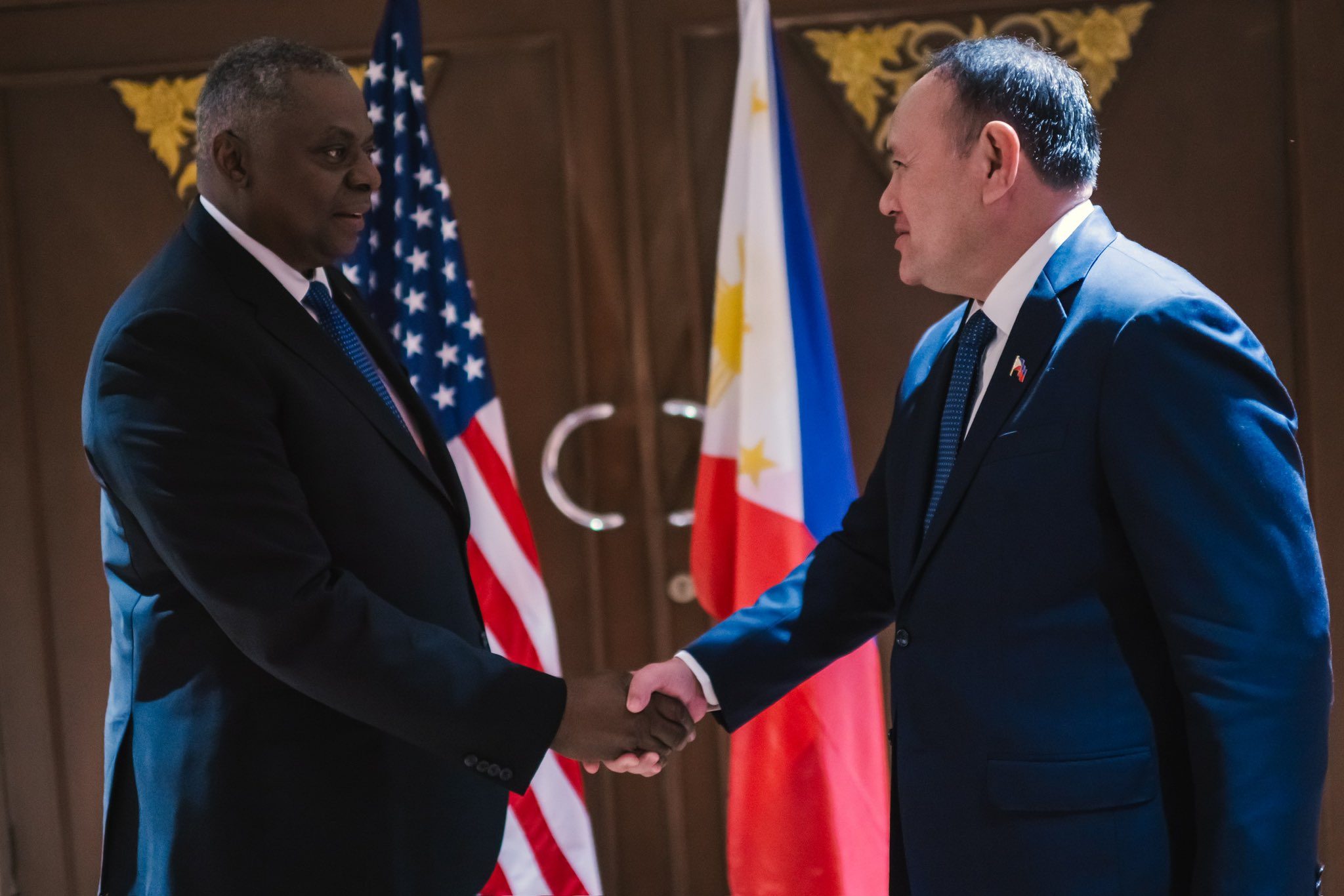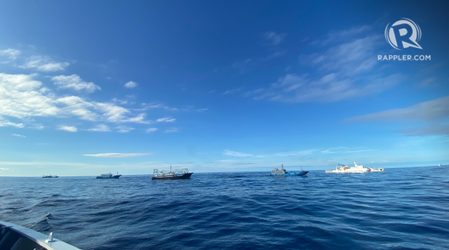SUMMARY
This is AI generated summarization, which may have errors. For context, always refer to the full article.

MANILA, Philippines – United States Defense Secretary Lloyd Austin said on Wednesday, November 15, that Washington “stands shoulder-to-shoulder” with Manila “in defending its sovereign rights and jurisdiction in its Exclusive Economic Zone,” during a meeting with Philippine Defense Secretary Gilberto Teodoro in Jakarta, Indonesia.
The two met on the sidelines of the Association of Southeast Asian Nations (ASEAN) Defense Ministers’ Meeting-Plus.
Austin also reaffirmed US President Joe Biden’s earlier pronouncements of the “ironclad” defense commitments of the United States to the Philippines.
“The Secretaries reaffirmed that the Mutual Defense Treaty extends to both countries’ armed forces, public vessels, and aircraft—including those of its Coast Guard—anywhere in the Pacific, to include the South China Sea,” read a joint statement from the spokesperson of the Philippines and US defense departments.
The meeting – and Austin’s statements – come just days after Chinese vessels harassed and acted aggressively against Philippine vessels on a resupply mission to a naval outpost in Ayungin Shoal or Second Thomas Shoal in the West Philippine Sea.
The Philippines was vastly outnumbered – three Philippine Coast Guard vessels and two resupply boats to China’s five China Coast Guard ships, 28 Chinese Maritime Militia, and five China Navy vessels in the area. A China Coast Guard vessel even used a water cannon to intimidate the ML Kalayaan, a small ship that was carrying supplies.
Yet the Philippines, with its Japan-made BRP Melchora Aquino in tow, managed to outmaneuver and out-strategize China’s overwhelming fleet of ships.
Ayungin Shoal problem
Harassment during resupply missions to Ayungin Shoal have become as routine as the missions themselves. Worse things have happened in the past – China has used water cannons and military-grade lasers, and an October 22 resupply mission resulted in one collision between China Coast Guard and Philippine resupply boat, and a Philippine Coast Guard ship and a Chinese Maritime Militia vessel grazing each other.
Ayungin Shoal, guarded by the rusting BRP Sierra Madre, is a low-tide feature that’s well within the Philippines’ exclusive economic zone. But China, with its sweeping claim over the South China Sea, claims it as theirs, too.
A readout from the Philippine and US defense spokesperson said the two defense chiefs “reaffirmed their countries’ shared vision of a free and open region grounded in transparency, the rule of law, respect for sovereignty, and the peaceful resolution of disputes.”
“The Secretaries discussed the importance of preserving the rights of all nations to fly, sail, and operate safely and responsibly wherever international law allows. In this context, they denounced the recent harassment by vessels from the People’s Republic of China (PRC) towards Philippine Coast Guard and resupply vessels conducting lawful resupply operations around Second Thomas Shoal, as well as dangerous operational PRC maneuvers against US aircraft and ships lawfully operating in the South China Sea,” it added.
The Philippines and US are treaty allies, bound by agreements that cover the promise of mutual defense, of allowing troop deployments for joint drills, and of allowing Americans access to select Philippine military bases for the prepositioning of assets.
The ASEAN Defense Ministers Meeting-Plus has been held annually since 2017 to help build ASEAN members’ capacity to address shared security challenges and strengthen cooperation for peace in the region. The Plus countries include dialogue partners Australia, China, India, Japan, New Zealand, Korea, Russia, and the US.
ALSO ON RAPPLER
- ANALYSIS: The most complicated dispute in the world
- What access to Canada’s dark vessel detection means for the Philippines
- [ANALYSIS] BRP Sierra Madre and the complexities of geopolitics in the West Philippine Sea
- Hindi Ito Marites: Threesome ng Japan, US, at Pilipinas
Manila back in Washington’s arms
Philippine and US ties have warmed and moved forward under President Ferdinand Marcos Jr., in contrast to the tense ties under former president Rodrigo Duterte.
Marcos has made clear that he wants closer ties – especially in defense and security – with the US. The Palace announced the opening of more bases for the Americans, following Marcos’ state visit to Beijing.
The Philippines President himself has said he “cannot see the Philippines in the future without having the United States as a partner.”
Marcos is set to further that relationship, too, during his official visit to the US for the Asia Pacific Economic Cooperation Summit. The Philippine President will be visiting Hawaii, during which he’ll pay a visit to the Indo-Pacific Command, the largest unified command in the US military that has jurisdiction in the region the Philippines is part of.
The Philippines’ decision to move closer to Washington has drawn disdain from Beijing, which has blamed the US for the rising of tensions in the South China Sea.
Marcos, in turn, said during the August 2023 ASEAN Summit in Jakarta, that the Philippines “rejects misleading narratives that frame the disputes in the South China Sea solely through the lens of strategic competition between two powerful countries.”
ASEAN defense ministers, in their joint declaration following the Jakarta meeting, said the bloc “notes” the “geopolitical and geostrategic dynamic shift in the region and the impacts of major power rivalry that could threaten stability and peace in the Southeast Asia region and beyond, and possibly affect the security and prosperity of ASEAN.” – Rappler.com
Add a comment
How does this make you feel?




![[ANALYSIS] How one company boosts farmer productivity inside the farm gate](https://www.rappler.com/tachyon/2024/06/bioprime-farmgate-farmer-productivity-boost.jpg?resize=257%2C257&crop=465px%2C0px%2C1080px%2C1080px)

![[In This Economy] Is the Philippines quietly getting richer?](https://www.rappler.com/tachyon/2024/04/20240426-Philippines-quietly-getting-richer.jpg?resize=257%2C257&crop=194px%2C0px%2C720px%2C720px)



![[Just Saying] SONA 2024: Some disturbing points](https://www.rappler.com/tachyon/2024/07/TL-marcos-sona-points-july-23-2024.jpg?resize=257%2C257&crop=335px%2C0px%2C720px%2C720px)

There are no comments yet. Add your comment to start the conversation.